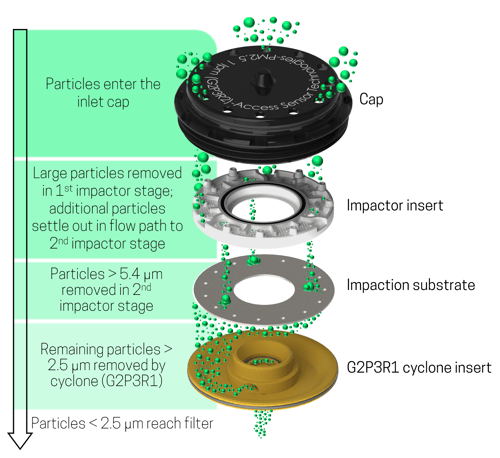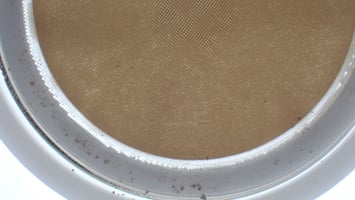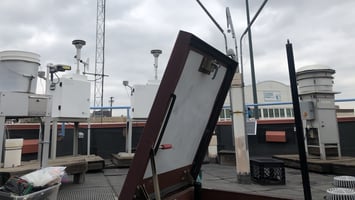What does it mean for a sample to be "overloaded"? When a sample is said to be "overloaded," that...
Introducing the pre-cyclone impactor
What is the pre-cyclone impactor?
The pre-cyclone impactor is a device that can be installed in our GEN2 1 LPM PM2.5 inlet to make the inlet more resistant to overloading and large-particle breakthrough.
Without the pre-cyclone impactor, our 1 LPM PM2.5 inlet operates as a single-stage inlet that uses a PM2.5 cyclone to remove particles with aerodynamic diameters > 2.5 µm from the incoming airflow. With the pre-cyclone impactor installed, our GEN2 1 LPM PM2.5 inlet operates as a three-stage inlet that removes particles with aerodynamic diameters > 2.5 µm from the incoming airflow using a multi-stage impactor followed by the same PM2.5 cyclone.
If the previous two sentences sounded like a bunch of aerosol nerd nonsense: when the 1 LPM PM2.5 inlet is used without the pre-cyclone impactor, there is only one step in which particles with aerodynamic diameters > 2.5 µm can be removed from the incoming airflow. With the pre-cyclone impactor, there are three steps in which large particles can be removed from the incoming airflow. Adding two more steps makes it less likely that the final step becomes overwhelmed with large particles and fails to operate as intended.
The pre-cyclone impactor consists of two pieces: (1) a white plastic impactor insert and (2) a sintered stainless steel impaction substrate.
How does it work?
The pre-cyclone impactor is designed to remove particles with aerodynamic diameters > 5.4 µm from the sample air before that air reaches the inlet of the PM2.5 cyclone. These particles are removed in three steps (see figure to right):
- Immediately after air enters the inlet through the holes in the cap, very large particles hit the top surface of the white plastic impactor insert and get stuck there.
- As the air passes through the textured flow paths on the top of the impactor insert, large grit and fibers either settle out of the flow or get stuck to the walls.
- The air is then accelerated through the three holes in the impactor insert, which causes particles with aerodynamic diameters > 5.4 µm to hit and stick to the oiled stainless-steel impaction substrate.
Smaller particles, which have less inertia and can therefore change directions more easily, follow the air flow path through the holes in the impaction substrate. These particles then enter the inlet of the cyclone, where particles with aerodynamic diameters between 5.4 and 2.5 µm are removed from the airflow.
When using the pre-cyclone impactor, you may optionally coat the top surfaces of the impactor insert with a very thin film of silicone oil to aid large particle retention in steps 1 and 2 above. The stainless steel impaction substrate must be oiled to facilitate particle removal by impaction in step 3.
How do I know if I need the pre-cyclone impactor?
You might need to use the pre-cyclone impactor if dust and/or large pieces of ash are prevalent in your sampling environment.
If you've collected samples using our PM2.5 1 LPM inlet without the pre-cyclone impactor and found that: (a) a non-negligible fraction of those samples had signs of overloading and (b) that overloading was characterized by large-particle breakthrough, we recommend adding the pre-cyclone impactor to your inlet. If you didn't know that you should evaluate samples for signs of overloading or you're not sure where to start with such an evaluation, read this blog post to learn more.
Are there any disadvantages to using the pre-cyclone impactor?
The pre-cyclone impactor should always have a positive or neutral impact on the performance of the PM2.5 1 LPM inlet; however, use of the pre-cyclone impactor will require additional labor on your part compared to use of the PM2.5 1 LPM cyclone alone. That's because:
- The pre-cyclone impactor adds two additional parts to the PM2.5 1 LPM inlet that will need to be cleaned regularly between samples: the impactor insert and the impaction substrate.
- You must add oil to the impaction substrate regularly.
- You might (optionally) choose to apply oil to the top surfaces of the impactor insert regularly.
If the pre-cyclone impactor was designed to make the 1 LPM PM2.5 inlet work better, does that mean all samples that have been collected without the pre-cyclone impactor are bad?
No. Although the 1 LPM PM2.5 cyclone can become overloaded under the "wrong" conditions (which is a potential pitfall for all size-selective PM inlets), that does not mean every sample collected without the pre-cyclone impactor in the 1 LPM PM2.5 inlet is overloaded and bad.
Am I sure? Yes. How am I sure? We've been selling our 1 LPM PM2.5 inlet since 2017 and, since that time, numerous studies have found that PM2.5 concentrations derived from filter samples collected with our 1 LPM PM2.5 inlet on the UPAS agree with PM2.5 concentrations derived from filter samples collected with a variety of other PM2.5 inlets:
- Arku et al. (2018) found that PM2.5 measurements made with the 1 LPM PM2.5 inlet on the UPAS generally agreed with PM2.5 measurements made using Harvard Impactors. These measurements were made with both samplers collocated in stationary locations in the cooking areas within Indian homes. See Figure 5 and the text in Section 3.3.2 of their publication.
- Pillarisetti et al. (2019) found that PM2.5 measurements made with the 1 LPM PM2.5 inlet on the UPAS generally agreed with PM2.5 measurements made with the Mesa Labs SCC 1.062 Triplex cyclone attached to the SKC AirChek XR5000 personal sampling pump. They measured personal exposures among women who lived in rural Honduras, were the primary cooks for their households, and who cooked using wood-burning stoves. See Figure 2, Table 1, and the text in Section 3 of their publication.
- Burrowes et al. (2020) also found that PM2.5 measurements made with the 1 LPM PM2.5 inlet on the UPAS generally agreed with PM2.5 measurements made with the Triplex cyclone attached to the XR5000 personal sampling pump. These measurements were made with samplers collocated (a) in stationary locations in kitchens of Peruvian homes where crop residue, wood, and dung were commonly used as cooking fuels as well as (b) on aprons worn by study participants and personnel. See Figure 2 and the text in Section 3.3 of their publication.
One limitation associated with these comparisons is that all three of the studies listed above focused on settings in which PM2.5 pollution was expected to be dominated by particles from biomass burning. In these settings, it is likely that the majority of PM2.5 mass consisted of particles much smaller than 2.5 µm in aerodynamic diameter. On the other hand, one strength associated with these comparisons is that all three studies took place in "real-world" environments where particles of a variety of sizes and from a variety of sources would have been present.
Can I use the pre-cyclone impactor with any of your PM2.5 1 LPM inlets?
You can use the pre-cyclone impactor with any GEN2 PM2.5 1 LPM inlet that has an "R1" cyclone insert (see Table 1). The R1 cyclone insert includes a special "step" where the pre-cyclone impactor sits.
You cannot use the pre-cyclone impactor with (1) a GEN1 PM2.5 1 LPM inlet nor (2) a GEN2 PM2.5 1 LPM inlet that has an "R0" cyclone insert; however, all GEN2 PM2.5 1 LPM inlet caps (R0, R1, and R2) are compatible with both R0 and R1 inserts. If you have a GEN2 PM2.5 1 LPM inlet with an R0 insert, you can get a new R1 insert to replace the R0 insert.
Look at the markings in the brown plastic piece on the bottom of your GEN1 PM2.5 1 LPM inlet to determine whether it contains an R1 cyclone insert (see Table 1). Note that the markings on the top of the black aluminum cap do not indicate whether the inlet contains an R1 cyclone insert.
 |
 |
 |
|
GEN1 PM2.5 1 LPM inlet
|
GEN2 PM2.5 1 LPM inlet | Markings on the bottom of a GEN2 PM2.5 1 LPM inlet indicating that it has an R1 insert. |
|
Not compatible with pre-cyclone impactor
|
Compatible with pre-cyclone impactor only if it has a G2P3R1 ("R1") cyclone insert
|
Compatible with pre-cyclone impactor |
|
GEN1 inlets were sold before 2020.
|
GEN2 inlets have been sold since 2020. | All GEN2 PM2.5 1 LPM inlets sold since July 2024 have included R1 inserts. |
Where can I learn more?
You can read more about the pre-cyclone impactor in our Size-Selective Inlet User Guide. This document includes laboratory data on the performance of the pre-cyclone impactor as well as instructions for using and maintaining the pre-cyclone impactor. You can download the most recent version of the Size-Selective Inlet User Guide from our Inlets and Accessories page.
How can I acquire pre-cyclone impactors?
If you would like to purchase the pre-cyclone impactor, please fill out this order form. We are offering the pre-cyclone impactor at a special introductory price until 15 September 2025.




